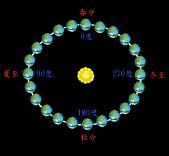How do you decide a leap year according to solar terms? The 24 solar terms is a gross name of the system that comprises of 12 major solar terms and 12 minor solar terms interlaced with each other. Starting from "雨水spring showers ", the 12 major solar terms are "雨水spring showers ", "春分vernal equinox", "谷雨corn rain", "小滿corn forms", "夏至summer solstice", "大暑great heat", "處暑end of heat", "秋分autumnal equinox","霜降frost", "小雪light snow", "冬至winter solstice", and "大寒severe | 
|
cold" . Each major solar term falls on one of the 12 lunar months, designated by the 12 earthly branches. The minor solar term after "雨水spring showers " is "驚蜇insects waken" and then in turn "清明bright and clear", "立夏summer commences", "芒種corn on ear", "小暑moderate heat", ?"立秋autumn commences", "白露white dew", "寒露cold dew", "立冬winter commences", "大雪heavy snow", "小寒moderate cold", and "立春spring commences".
In the Agricultural Calendar, each lunar month contains a major solar term. A lunar month that does not include a major solar term is taken as the leap month of the preceding month. In 19 tropical years there will be 228 major solar terms and 235 months. Therefore, 7 lunar months will not contain major solar terms and they are classified as leap months. |